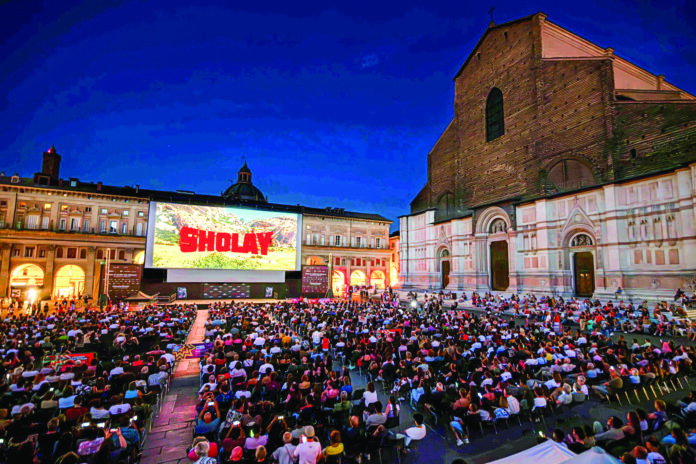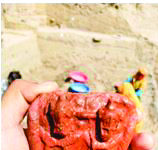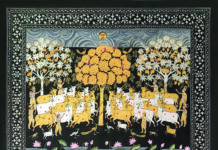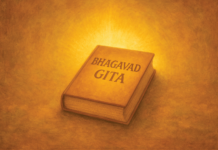Sholay’s restored uncut version screened in Bologna, marking 50 years; original climax shown, celebrating Indian-Italian cinema collaboration and heritage
Fifty years after its thunderous arrival in Indian theatres, Sholay, one of the most celebrated films in Indian cinema, blazed back onto the screen — this time under the open sky in the historic Piazza Maggiore of Bologna, Italy.
It was no ordinary screening. Cinephiles from across the globe gathered for a glimpse of the newly restored, uncut version of Ramesh Sippy’s timeless classic, a version that finally allowed audiences to witness scenes long buried in the archives, including the original climax — which shows Gabbar Singh being killed by Thakur instead of arrested by police, and previously deleted scenes that were not part of the widely distributed theatrical cut Sholay, with its unforgettable ensemble of Amitabh Bachchan, Dharmendra, Hema Malini, Jaya Bhaduri Bachchan, Sanjeev Kumar, and the menacing Amjad Khan as Gabbar Singh, was first released in 1975 and swiftly grew into a cultural phenomenon. The tale of friendship, revenge, and sacrifice resonated with audiences for generations, spawning catchphrases, fan clubs, and countless reinterpretations across media.
This year, to commemorate the film’s golden jubilee, the Film Heritage Foundation, led by its indefatigable founder Shivendra Singh Dungarpur, collaborated with the renowned Cineteca di Bologna to bring the complete Sholay back to life. The world premiere of the uncut print formed the centrepiece of the Il Cinema Ritrovato Festival, Bologna’s annual tribute to the lost and found treasures of world cinema. This landmark screening was made even more special by the recognition of the very person who had made it possible. At a special ceremony during the festival, Shivendra Singh Dungarpur was awarded the prestigious Vittorio Boarini Award by Gian Luca Farinelli, Director of the Fondazione Cineteca di Bologna.
The award, named in honour of the visionary founder and first director of the Cineteca, is an international tribute to individuals or institutions whose dedication to film preservation, restoration, and dissemination has kept cinema’s cultural heritage alive for future generations. “This is an incredibly proud moment for both India and Italy. We are not just showcasing Italian films here in Delhi, but we are also celebrating India’s cinematic legacy in Bologna. Sholay being screened in its restored glory is nothing short of historic,” rejoiced Andrea Anastasio, Director of the Italian Embassy Cultural Centre, who has been a key figure in strengthening Indo-Italian cultural ties through cinema. Anastasio, who has been instrumental in projects such as the Italian Focus at the Habitat International Film Festival, underlined the role of such cultural exchanges in deepening understanding between the two nations.
“Most of the work we do is aimed at generating a beautiful platform where India and Italy can know each other in a deeper way. Culture is the most organic and honest way to do this. The relationships we’ve cultivated with Indian institutions, filmmakers, and writers have created a shared sense of trust, which keeps motivating us to go ahead.” Indeed, the revival of Sholay was only one chapter in a much broader narrative of cinematic collaboration that has been unfolding quietly but steadily. Anastasio also talked about the recently concluded 8th edition of Fare Cinema (“To Make Cinema”), an annual international celebration of Italian cinema, presented in partnership with the Italian Ministry of Foreign Affairs and International Cooperation.
Launched in 2018 by the Italian Ministry of Foreign Affairs and International Cooperation, the initiative brings the best of Italy’s modern cinematic voices to audiences around the world. The films showcased in Fare Cinema 2025 represented a mix of awardwinning biopics, socially relevant dramas, and promising debut features. Enrico Piaggio – Un Sogno Italiano narrated the inspiring post-WWII story of the man behind the Vespa, a name that still resonates in India where Piaggio vehicles remain a familiar sight. Settembre, described by Anastasio as a romantic tale that “picks up serious themes under gentle layers,” explored how relationships and society have evolved in modern Italy. And Giuseppe Fiorello’s Stranizza d’amuri, a tender yet brave debut, revisited conservative Sicily of 1982, weaving a deeply moving coming-of-age story of two young boys discovering themselves during Italy’s World Cup victory — a film that has already earned the coveted David di Donatello award for Best First Film.
“These works show how Italian cinema is evolving after its classic, experimental, and Renaissance phases,” said Anastasio. “Today, young directors and actors are not just aware of the past—they are reshaping it. Even TV serial culture has entered the cinematic language in nuanced ways.” Looking ahead, Anastasio hinted at bigger things to come. Plans are already underway to bring restored Italian and Indian classics to Delhi in the coming year, promising Indian audiences a chance to reconnect with cinema as cultural heritage.
The Italian Embassy Cultural Centre is also set to host exhibitions and public lectures exploring lesser-known historical ties — including a major showcase at the Humayun’s Tomb Museum and a lecture series led by scholars like Naman Ahuja, tracing Indo-Roman connections through Gandhara art and maritime trade routes. For now, though, the echoes of Sholay’s iconic dialogues ringing through Piazza Maggiore will remain etched in the memories of all who gathered there that magical evening.








